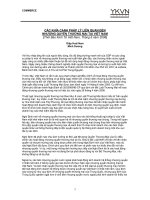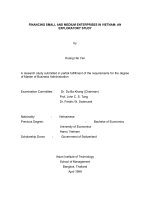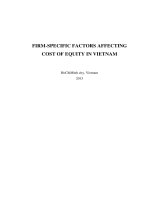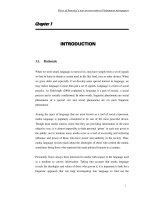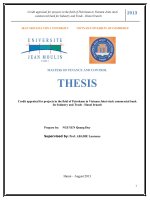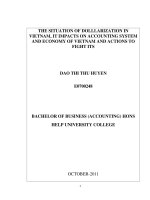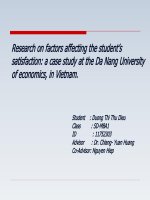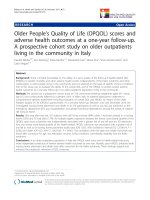Dao people’s rite of passage in Vietnam
Bạn đang xem bản rút gọn của tài liệu. Xem và tải ngay bản đầy đủ của tài liệu tại đây (849.12 KB, 5 trang )
VĂN HÓA TRUYỀN THỐNG VÀ PHÁT TRIỂN
DAO PEOPLE’S RITE OF PASSAGE IN VIETNAM
Ban Tuan Nang
Ho Chi Minh National Academy of
Politics
Email:
Received: 12/10/2019
Reviewed: 18/10/2019
Revised: 26/10/2019
Accepted: 9/11/2019
Released: 20/11/2019
DOI:
R
ite of passage is a ritual imbued with the Dao cultural
identity. This is the topic that many researchers are
interested in approaching the cultural life of the Dao people, but to
find a definition with adequate content is still a problem that has not
been thoroughly studied, there are still debate and inconsistency
on opinion. This paper, within the scope of the study, describes the
basic contents of the ceremony from the lowest level (3 lights) to
the highest one (12 lights), through which the definition of rite of
passage is given their identity and value in the spiritual life of the
Dao people.
Keywords: Rite of passage; Dao people; 3 lights ceremony; 7
lights ceremony; 12 lights ceremony; Definition of rite of passage.
1. Introduction
Researchers, when approaching the Dao
culture, recognize that the rite of passage (lễ cấp
sắc) ceremony is a universal cultural characteristic.
However, to acutely understand this ceremony of
Dao people, until now, there are still quite vague
ways of understanding.
Researching and interpreting to reach full
awareness of a universal cultural phenomenon of
the ethnic group is necessary, especially when this
ritual is always characterized by historical - cultural
life of the Dao people.
2. Study overview
Previously, many Vietnamese scholars when
approaching the rite of passage often affirmed that it
was a vestige of the custom, with some people agree
that the ceremony is an initiation rite. Therefore,
sometimes to explain it specifically, it is also known
as the Initiation Rite of the Dao male. However, in
the ritual complex of this ritual, there are many
small ceremonies, such as the call-enter ceremony
of soldiers, the opening ceremony of the sky gate,
praying for good crops, the granting of lights and
soldiers, worshiping ceremonies to Ban Vuong
ancestor, the ceremony of bringing couples to cross
the river/sea, the ceremony of granting yin and
yang scrolls for the attending couple... With such
a complicated ritual complex, to understand and
make specific and accurate judgments for the rite
of passage is an issue that needs to be approached
from the overall perspective and details of the entire
ritual system from the lowest to the highest ranks,
including: 3 lights, 7 lights and 12 lights ceremony...
Currently, the concept and nature of the rite of
passage in the Dao ethnic group in general are still
discussed by researchers. According to the authors
of Dao people in Vietnam (Dang, Tung, Trung, &
Tien, 1971), the rite of passage is a very popular
106
custom among the Dao people and compulsory
for all Dao men. In terms of origin, rite of passage
is a social activity phenomenon, later it is put on
a “religious” cover, which is so bold that at first
glance it looks like a mere religious ritual. Besides,
these authors assert, the overarching meaning of
this ritual of the Dao people includes many aspects
such as: the person who passed into the new level
becomes an adult, can do worship, when he dies,
his spirit will reunite with ancestors...(Dang et al.,
1971, pp.278-279). According to author Le Sy Giao,
by nature the rite of passage are considered to be an
expression of the initiation, a challenge for young
people to officially enter the adult world. Of course,
the Dao’s rite of passage is not a exact clone of an
initiation, but it is tinted with shamanism and aims
to train young people to become shaman masters
(Giao, 1996, pp.1-3)
3. Research method
The paper uses basic research methods: Methods
of collecting secondary documents, methods of
description, synthesis, comparison.
4. Research results
4.1. 3 lights ceremony and its significance in life
4.1.1. Naming rituals
For the Dao people, the child born must be named;
The naming must be read in the worship book and
must be carried out with the ancestors. For the Dao
Tien group in two provinces of Bac Kan and Cao
Bang, the ritual sequence was conducted as follows:
- Informing ancestor and unofficial naming
ceremony for young children (búa phàm chiu)
With the Dao Tien people, the homeowners
celebrate the búa phàm chiu with the purpose of
informing the ancestors’ ghosts. During this time,
pregnant women and infants must be in a closed
room, only the husband and the mother-in-law are
JOURNAL OF ETHNIC MINORITIES RESEARCH
VĂN HÓA TRUYỀN THỐNG VÀ PHÁT TRIỂN
allowed in and out. After performing the ritual, the
mother is given some kind of stem, roots, leaves
of medicinal plants to bathe by her mother-in-law
(or her sisters), and she can go out to do some light
work. At the ritual of búa phàm chiu, the name
of the child when used is used in numerical order
(unofficial name), specifically as follows:
Son names
First son
cắn ton
Second
son
bía nái
Third son
bía lún
Fourth son
bía đam
Fifth son
bía diếu
Sixth son
bía mản
Seventh
son
bía coộc
Eighth son
bía lỉu
Daughter names
First
sía mụi
daughter
Second
sía nái
daughter
Third
sía lún
daughter
Fourth
sía đam
daughter
Fifth
sía diếu
daughter
Sixth
sía mản
daughter
Seventh
sía coộc
daughter
Eighth
sía lỉu
daughter
Because the naming is done according to the
order of the children, when praying, the shaman
must clearly state which child this is, who the
parents are and where they reside...; In case the
father of the child has not issued three lights,
the name of the child and the father will only be
witnessed by the ancestors, but cannot receive the
protection of magicians. When they need ancestors
help, ancestors will be more difficult to identify
than the children whose fathers have yin names
(that is, the special name which has magicians to
assist, lead or help in the underworld). Obviously,
this concept also creates psychological pressure,
making the practice of 3 lights ceremony in the Dao
Tien community always become necessary.
- Birth ceremony, giving an official name to
the child (pháo nin sành)
The time for pháo nin sành ceremony at home
does not depend on the age of the child. For boys, it
is mandatory to perform this ceremony before they
perform the 3 lights ceremony, that is, the naming
of the yin name. In other words, adult Dao men
need to have 2 names, 1 in the secular world and 1
in the underworld (pháp danh). Dao women grow
up, before going to get married, they also have to
go through pháo nin sành ceremony, which means
they also have two names.
If at the ancestor worship ceremony, the child’s
name only makes sense in the family life, the pháo
nin sành ceremony is more towards the community.
However, the official naming for the community
Volume 8, Issue 4
to recognize the Dao Tien people is simple, almost
no witchcraft and magic elements appear. The
conception of the people about this ritual is similar
to that of the neighboring peoples: Finding people
who is good with words and piety, and invite them
to name their children in order that all good things
will come to them. This name must be announced
to the ancestors and the ghost in the house, for
them to support the child. Therefore, since then,
the child in the family should not arbitrarily change
the name, because this is the name recognized by
both the secular and underworld. This also explains
why in the past, in some areas where Dao children
went to school, the previous school year name of a
student was Hue, the following school year it was
changed to Hoa. When teachers call their former
names, they definitely do not answer, leading to
difficulty in learning and examination. The reason
is that families have not conducted birth ceremony,
naming their children officially so when they go to
school, they choose a good name for themselves and
the right to change according to their preferences.
- Renaming ceremony for children who are
difficult to raise (trúi miến)
Normally, according to traditional practices,
children who were born and raised if they were
sick, their parents would invite shaman. In terms
of meaning, this offering is similar to that of the
Kinh people; worship Mother Bjooc, Mother
Va... of the Tay and Nung people... If doing that
and children are still often sick, they must make
a ceremony to change the name, because the Dao
Tien people believe that there is some kind of
ghost disagree with the child’s name. This ritual is
usually conducted when children know how to walk
and eat rice until about 9-10 years old, but popular
in the period from 1 to 6 years old. Depending on
the needs of the homeowner, the shaman conducts
a renaming ceremony for the child in one of the
following two ways:
The first way: The child’s parents go to the forest,
find a big rock and adopt it as a foster parent for the
child, the rock is considered as a guardian object for
the child. The name of the child then often called
“Thach” (meaning stone) or “Lam” (meaning
forest). In order to perform the ceremony (Dao
Tien people call it a trúi bánh), the shaman and his
parents brought the child and some rice, wine, meat,
paper money, incense to the chosen rock to present
the gifts and make the rock bless the children to
grow up healthy. After that, the shaman burned
paper money and brought home gifts, offered rice
to cook porridge or cooked rice for children to eat.
Next, on the first and second days of the first and
second month, the parents brought the rice to the
rock to offered it, then brought it back and cooked
for the children. When children are healthy again,
do not call them “Thach” or “Lam” anymore but
called “Bánh”. Since then, on the occasion of the full
107
VĂN HÓA TRUYỀN THỐNG VÀ PHÁT TRIỂN
moon of the seventh lunar month and the first days
of the year, the homeowner must bring offerings
to the rock until the children grow up, pass the rite
of passage or get married. It should be added that,
during the above process, whenever Bánh gets sick,
if he tells what his “adoptive parents” dislike, the
homeowner must invite the shaman there to make
an apology and make a call for its soul.
The second way: The Dao Tien people here
also have a ritual to change the name for the child
called “trúi phính”, that is, change the child’s name
completely by the name of a certain family of the Dao
Tien people. First, the homeowner asked the shaman
to see if the child suited the family, then they will to
go to the head of the lineage’s family to complete the
procedures. If the elder’s house is far away, a family
member may ask for permission, bring an offering to
the altar, and burn incense to request the ancestor’s
ghost to bless the healthy child. In this case, if the
surname Trieu, the child’s name is Trieu; Ban family
- the name of the child is Pien... Every year, on the
occasion of the Lunar New Year and the Full moon
in July, the homeowner must bring some offerings to
burn incense and thanksgiving at the ancestral altar
of that family. It ends when children get married.
But with respect to their ancestors, grateful to their
roots, many married couples still visit their adoptive
parents on Tet and holidays.
Thus, looking at each ritual can see, all kinds of
names, even of the individual, must be witnessed by
the gods and ancestors. That is, the domination of
the spiritual world of Taoism and ancestor worship
for each individual being started from birth. This is
also the first reason leading to the implementation
of the 3 lights ceremony in order to give a yin name
(a special name), to grant a shrine and soldiers to
the worshippers, which is still practiced popularly
among Dao Tien people today.
4.1.2. 3 lights ceremony
For Dao Tien’s male in particular and the Dao in
general, in addition to performing the rituals related to
naming above, it is also necessary to perform the rite
of passage when that person reaches the prescribed
age to have more name (also known as yin name –
phạt búa). In the process of performing the rite of
passage, the worshipers are given the procedures
by granting the names of the yin name, shrines and
soldiers, in order to clear and enlighten the soul. The
soldiers will help the person who has received the
rite of passage with the army, the power... to manage
the affairs of the worshiping ceremony.
According to the regulations of the Dao people
in the Mien dialect, with 3 lights ceremony, the
beneficiary is provided with 3 shrine lights and
36 soldiers. The three-level ceremony of lights
basically consists of these main ceremonies: The
ceremony to announce the prayers of the gods;
Ceremony for granting 3 lights (quá tang); Soldiers
108
dance; Ceremony to see off the gods, wizards, and
Ban Vuong ancestors to their old residence.
Thus, if you look at the rituals in the 3 lights
ceremony, you can see that the central nucleus lies in
the providing of the 3 lights and the soldiers for the
beneficiary. In order to be granted lights and soldiers,
the beneficiary must be given a yin name first. Only
when he has a yin name, he is considered to be a
mature man, qualified, capable to run the work on
the underworld. This is the detail that makes many
people confuse this ceremony and the initiation.
4.2. 7 lights and 12 lights ceremony and theirs
significance in life
Surveys in the provinces of Bac Kan, Cao Bang,
Lang Son, Tuyen Quang, Ha Giang ... showed that
most of the Dao groups in Vietnam today only
perform the ceremony of 3 lights and 7 lights, the 12
lights ceremony seems to have very little existence.
As for the Dao Tien people in Ngan Son district
(Bac Kan) and Nguyen Binh district (Cao Bang),
many families still have the ability to perform the
12 lights ceremony. In this ceremony, the 7 lights
ceremony is only a transitional step within the
12 lights ceremony. At the 7 lights ceremony, the
beneficiary is granted 7 shrines and 72 soldiers; At
the 12 lights ceremony, the beneficiary is given 12
shrines and 120 soldiers.
In daily life, the relationship between people
granted with three lights and 12 lights is no
difference, only difference in position when people
have died. The fact also shows that the Dao Tien
custom dictates the order of gradation according to
the hierarchy and the generation, in which 3 lights
gradations are compulsory, the 7 lights and 12 lights
are combined into a ritual, but currently only exist
in some families reside in Ngan Son district (Bac
Kan) and Nguyen Binh (Cao Bang). Therefore, the
relationships between the 3 lights, 7 lights and 12
lights people only have spiritual meaning, that is
related to the concept and worship together with the
ideas behind death. Particularly, the level of 3 lights
is required, so almost every man goes through and
must follow the order of hierarchy; Therefore, the
relationships between families with people who has
not done the rite of passage are less discriminatory,
because those who have not been ordained are yet to
turn. The problem is that, among the granted people,
later those who take the effort to learn and become
good worshipers are reputable in the Dao community.
Unlike the 3 lights ceremony, which is usually
held within the family, 7 and 12 lights are attended
by many families. Particularly for the Dao Tien
group in Ngan Son district (Bac Kan) and Nguyen
Binh (Cao Bang), the 12 lights ceremony has the
participation of the whole family. During the
implementation process, the 12 lights ceremony
of the Dao Tien people here was divided into 2
separate rituals: - Sìn pè đàng ceremony - organized
JOURNAL OF ETHNIC MINORITIES RESEARCH
VĂN HÓA TRUYỀN THỐNG VÀ PHÁT TRIỂN
by the lineages to inform the gods and wizards
about their lineage. After preparing, go into the
process of prepare a man for the ceremony. After
the ceremony, the whole family abstained and
prepared for the tẩu sai ceremony according to the
time set by the head of the family and the shamans
before the sìn pè đàng ceremony.
The Dao Tien people believe that only when the
Dao man goes through this ritual will he become
the general in the afterlife. Therefore, the family
often elaborately prepare for this great ceremony.
The organization frequency is therefore also sparse,
usually about every 30 years for each lineage. In
particular, some families have to take 50-60 years
to organize once. The main rituals of the 12 lights
ceremony are: offering pigs to ancestors and deities
(lò mạ), worshiping the earth to help manage the
objects and welcoming wizards and soldiers (biêu
kiềm chê miền); Ceremony to worship ancestors
and gods about the family’s initiation of fasting for
the 12 lights (puồng chê); Presentation ceremony
of the spouse and the gods in 5 days of performing
the great ceremony of 12 lights (hỉu lùng pua puồng
chê piu); Ceremony to lead Sài ton soldiers to dance
(đồ thây); Also to worship the gods, wizards, and
soldiers to remain their positions when guiding the
soldiers of Sài ton to dance (dịa chiếm); Offering the
premature dead souls to reunite with their ancestors
(thinh tài nhuệ trì) and the big fortune-telling
ceremony to find the whereabouts of the ill-fated
spirits (tồm bâu); Ceremony and dance to share the
joy with the soldiers of Sài ton and the ill-fated souls
who were redeemed to reunite with their ancestors
(là chê); Offering gods to sharpening knives,
making stairs to Mieu Dai (mỏ dụ) and welcoming
good things to those who receive offerings (loàng
phinh); Ceremony to grant 7 lights and 12 lights for
Sài ton (quá tẩu sai tang) and opening the sky for
Sài ton (sài ton hỉu lùng); Ceremony to bring Sài
ton across the river (tẩu sùi dụ) and make offerings
to the Sài ton to be transformed into phoenixes to
fly up the five elements (pến sin pháo Tầu thây);
Ceremony to grant seals to the Sài ton (bêu diến)
and to take the wives of 14 Sài ton across the streams
(tẩu là choòng); Ceremony of granting colors to Sài
ton (quá chế), giving yin and yang to the couple
of Sai ton (là cháo chầy), adjusting the soldiers
(là chái peng); Ceremony to welcome good things
for the couple of Sài ton (phâu nghình doàng tấu),
the soldiers giving each Sài ton to Heavenly King
(puông nghình peng piu), reporting on heaven and
earth about the Tẩu sai (pua mài sán piu); Offering
thanks to our ancestors, shamans, soldiers, and land
guardian ... (séng loỏng).
Through a complex of ceremonies in the 12
lights great ceremony, it is clear that the mark of the
customs of the initiation has almost disappeared.
Instead, there are rituals imbued with Taoism,
interwoven with ancestor worship, animism...
Volume 8, Issue 4
Especially in the 12-lights ceremony, there are three
important rituals: - Ceremony invite the premature
dead souls to reunite with their ancestors (thinh tài
nhuệ trì) and the big fortune-telling ceremony to find
the whereabouts of the ill-fated spirits (tồm bâu). Dao
Tien people believe that in life, there are unfortunate
souls, when death is not granted, so they have not
been reunited with their ancestors. Therefore, they
must conduct the ceremony to find and redeem their
souls for reunion. This is a humanistic feature of the
spiritual life of the Dao people.
The third important ritual, also the focal point of
the 12 lights ceremony, is the ceremony of granting
yin and yang scrolls for each couple of disciples to
receive the ceremony. Yin is burned right after the
rite of passage, while yang will be burned until the
person dies. The souls of the deceased will follow
the guidance of that scroll to become a general, and
reunite spouses and descendants in the underworld.
This is also the most important purpose of the great
ceremony of the 7 and 12 lights in the spiritual life
of the Dao Tien people in particular and the Dao
people in general.
The results of the survey clearly show that at the
ceremony of the 7 and 12 lights of the Dao people,
the mark of the initiation in daily life was absent.
Instead it is the mark of a Taoist ritual localized in
the Dao faith.
4.3. Rite of passage definition
For the Dao people, the name for newborn babies
must be agreed by the ancestors and the gods, so it
is possible to identify clearly: - Taoism is localized,
tied to ancestor worship and many other primitive
beliefs, thus created their own colors in the spiritual
life of the Dao people and they became disciples of
this religion from the beginning.
At the 3 lights ceremony, the vestige of the
initiation is quite clear. However, this is no longer an
independent ritual of the initiation, but also includes
ancestral tributes and some Taoist rituals. At the 12
lights ceremony, the mark of the initiation became
completely absent. Therefore, if it is considered that
the rite of passage is the mark of the initiation or
the initiation rite of the Dao male at the 12 lights
ceremony, it is incorrect.
In our opinion, it is possible to give the definition
for the rite of passage from the lowest step (3 lights)
to the highest step (12 lights) as follows: The Dao
people’s rite of passage is a ritual conversion with
Taoist colors, but has been localized by the Dao
people, absorbing even Buddhism, Confucianism
and incorporating some primitive beliefs of the
ethnic group, the most prominent of which is the
custom of ancestor worship with the presence of
Ban Ho ancestor at every rituals. The two main
goals of the ceremony are to train and cultivate the
qualities and abilities of the shaman, and to show
the desire of each individual to be reunited to live
109
VĂN HÓA TRUYỀN THỐNG VÀ PHÁT TRIỂN
happily with their ancestors, to be good soul, good
general on the underworld after death. It is these
important goals that have become a continuous
thread, educating Dao individuals to live better and
more responsibly to family, friends, descendants,
and relatives in daily life, also help life become
more humane, bring more positive values in
many development stages of the ethnic group. In
daily life, Taoism and ancestor worship - Ban Ho
ancestor (Piền Hùng) govern each individual from
the common name (the name of the secular world)
and the special name (Taoism name, the afterlife
name so that their ancestors and grandparents can
recognize together), which makes individuals selfregulate their own behavior. This helps explain
why, many values of family culture, behavior in the
social life... of the Dao people are still sustainable.
5. Solutions to preserve the rite of passage of
the Dao people
At present, there are few Dao groups practicing
the original method of 12 lights ceremony. The
fieldwork results showed that the Dao Tien group
residing in Ngan Son district (Bac Kan) and Nguyen
Binh (Cao Bang) still maintained the organization
of 12 lights ceremony once in 30 years for each
family line. In addition, the Red Dao group residing
in Yen Bai area has also restored this ritual, but the
family line has been broken. Instead, there was the
participation of disciples from many families who
contributed money, rice, wine... to organize the
worshiping of the shamans. The number of married
References
Dang, B. V., Tung, N. K., Trung, N., & Tien, N.
N. (1971). Dao people in Vietnam. Hanoi:
Social Sciences Publishing House.
Giao, L. S. (1996). Dao’s rite of passage and
education of etiquette. Journal of Ethnicity
and Times, (No. 29), pp.1-3.
couples of disciples is no longer limited to 12 or 14
couples but can be up to 50 - 70 couples in the same
ceremony. Therefore, taboos within the lineage as
well as offerings and fortune-telling to find and
redeem the dead souls of the lineage to reunite
with the ancestors cannot be performed. Therefore,
in order to avoid being affected by cultural shifts,
making rituals likely to be deformed in the future,
it is necessary to have in-depth research programs
on the rite of passage of all Dao groups, especially
in documenting the 12 lights ceremony of the Dao
Tien group in Ngan Son district (Bac Kan province)
and Nguyen Binh district (Cao Bang province) to
research and propagate the positive values of the
ceremony. From that, helping the community and
researchers have a better view of the typical and
unique cultural features of the rite of passage in
the spiritual life of the Dao in particular, its unique
value in the treasure of cultural heritage of the
ethnic communities of Vietnam in general.
6. Conclusion
Researching on ethnic cultural characteristics,
accurately identifying the nature of each ritual
always brings many important values; helping
researchers have the right orientation in the process
of finding issues related to history, consciousness,
and the relationship between history and ethnic
culture in each stage of development. Hopefully this
research will add a voice to the research process of
ethnic culture in our country today and in the future.
Nang, B. T. (2017). The rite of passage of Dao
people in Vietnam. Hanoi: Ethnic Culture
Publishing House.
LỄ CẤP SẮC CỦA NGƯỜI DAO Ở VIỆT NAM
Bàn Tuấn Năng
Học viện Chính trị Quốc gia
Hồ Chí Minh
Email:
Ngày nhận bài: 12/10/2019
Ngày phản biện: 18/10/2019
Ngày tác giả sửa: 26/10/2019
Ngày duyệt đăng: 9/11/2019
Ngày phát hành: 20/11/2019
DOI:
110
Tóm tắt: Lễ cấp sắc là nghi lễ mang đậm bản sắc văn hóa
người Dao. Đây là nội dung được nhiều nhà nghiên cứu quan tâm
khi tiếp cận đời sống văn hóa người Dao, nhưng để tìm ra một định
nghĩa với đầy đủ nội dung, giá trị vẫn là vấn đề chưa được nghiên
cứu thấu đáo, vẫn có những tranh luận và sự thiếu thống nhất về
quan điểm. Bài viết này, trong phạm vi nghiên cứu, mô tả các nội
dung cơ bản của lễ cấp sắc từ cấp độ thấp nhất (3 đèn) đến cao nhất
(12 đèn), thông qua đó, đưa ra định nghĩa nhận diện nghi lễ cấp sắc
cùng giá trị của nghi lễ đó trong đời sống tâm linh của người Dao.
Từ khoá: Lễ cấp sắc; Người Dao; Lễ cấp sắc 3 đèn, Lễ cấp sắc
7 đèn; Lễ cấp sắc 12 đèn; Định nghĩa về lễ cấp sắc.
JOURNAL OF ETHNIC MINORITIES RESEARCH
